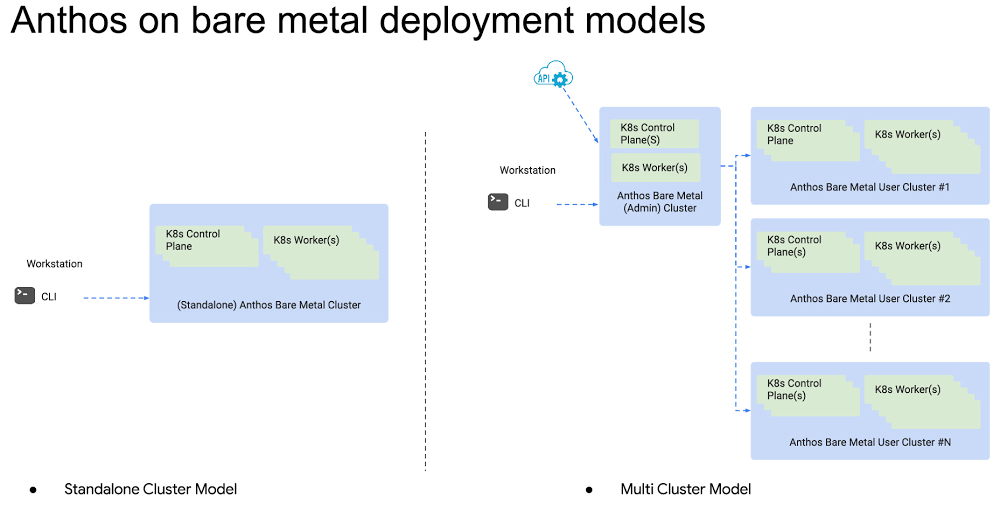GCP – Anthos on bare metal, now GA, puts you back in control
Enterprise IT organizations want it all, don’t they? Choice and freedom in their technology choices, but also automation, security, scale, and support. From the beginning, Anthos has been about putting you back in charge of how you consume the cloud (private or public), while imparting some of the best practices we’ve learned from running a global cloud at scale. With Anthos on bare metal, now generally available, we’ve gone a step further.
Anthos on bare metal opens up new possibilities for how you run your workloads, and where. Some of you want to run Anthos on your existing virtualized infrastructure, but others want to eliminate the dependency on a hypervisor layer, to modernize applications while reducing costs. For example, you may consider migrating VM-based apps to containers, and you might decide to run them at the edge on resource-constrained hardware.
Anthos on bare metal is generally available today, with subscription or pay-as-you-go pricing. Let’s dive into the specifics of Anthos on bare metal and also share technical details for how to get started.
Leverage your existing investments
Anthos on bare metal allows you to leverage existing investments in hardware, OS and networking infrastructure. The minimal system requirement to run Anthos on bare metal at the edge is two nodes with a minimum of 4 cores, and 32 GB RAM, and 128GB of disk space with no specialized hardware. The setup allows you to run Anthos on bare metal on most any infrastructure.
Anthos on bare metal uses a “bring your own operating system” model. It runs atop physical or virtual instances, and supports Red Hat Enterprise Linux 8.1/8.2, CentOS 8.1/8.2, or Ubuntu 18.04/20.04 LTS. Anthos provides overlay networking and L4/L7 load balancing out of the box. You can also integrate with your own load balancer such as F5 and Citrix. For storage, you can deploy persistent workloads using CSI integration with your existing infrastructure.
You can deploy Anthos on bare metal using one of the following deployment models:
-
A standalone model allows you to manage every cluster independently. This is a good choice when running in an edge location or if you want your clusters to be administered independently from on another.
-
A multi-cluster model allows a central IT team to manage a fleet of clusters from a centralized cluster, called the admin cluster. This is more suitable if you want to build automation, tooling or to delegate the lifecycle of clusters to individual teams without sharing sensitive credentials such as SSH keys or Google Cloud service account details.
Like with all Anthos environments, a bare metal cluster has a thin, secure connection back to Google Cloud called Connect. Once it’s installed in your clusters, you can centrally view, configure, and monitor your clusters from the Google Cloud Console.
We’ve been working on Anthos on bare metal with early-access customers and design partners, and their feedback has been overwhelmingly positive. For example, VideoAmp offers a video measurement and optimization platform, and uses Anthos on bare metal to help reduce the operational overhead of managing clusters while also maximizing the utilization of their cloud infrastructure.
“Here at VideoAmp, we run real-time compute-intensive applications, which enable advertisers to optimize their entire portfolio of linear TV, OTT and digital video to business outcomes. Kubernetes is a critical part of our strategy because of the scalability, portability, and flexibility it provides our developers,” says Hector Sahagun, Director of Engineering at VideoAmp. ”Anthos brings centralized lifecycle and policy management tools, allowing our infrastructure teams to focus on key initiatives instead of the day-to-day management of Kubernetes.”
Expanding the Anthos Ready Partner Program
We’re launching Anthos on bare metal with our partners in the Anthos Ready Partner Initiative. The program highlights partner solutions that adhere to Google Cloud’s interoperability requirements and meet the infrastructure and application development needs of enterprise customers running Anthos. These solutions are validated to work across Anthos deployment options including: Anthos on Google Cloud, Anthos on VMware, and Anthos on bare metal.
Atos, Dell Technologies, Equinix Metal, HPE, Intel, NetApp, Nutanix, NVIDIA, and other partners have committed to delivering Anthos on bare metal for their customers’ infrastructure requirements. In addition, our storage partners including Dell Technologies, HPE, NetApp, Portworx, Pure Storage, and Robin.io are providing shared storage solutions by qualifying their respective CSI drivers for Anthos on bare metal.
Finally, system integrators including Arctiq, Atos, IGNW, SADA, SoftServe, and World Wide Technology can help you get started with Anthos on bare metal with services and solutions to integrate Anthos on bare metal in your environment.
More workloads from more places, with more ease
No matter where you run your workloads—in Google Cloud, on-prem, in other clouds or at the edge—Anthos provides a consistent platform on which your teams can quickly build great applications that adapt to an ever-changing world. We developed Anthos to help all organizations to tackle multi-cloud, taking advantage of modern cloud-native technologies like containers, serverless, service mesh, and consistent policy management; both in the cloud or on-premises. Now, with the option of running Anthos on bare metal, there are even more ways to enjoy the benefits of this modern cloud application stack.
To learn more about Anthos on bare metal, check out this video, from which you’ll learn how to create a cluster and how to deploy your own application on an on-prem cluster. Then, if you’re interested in seeing how Anthos on bare metal can help your organization get hybrid cloud right, reach out to our sales team to schedule an architecture design session.
Read More for the details.



